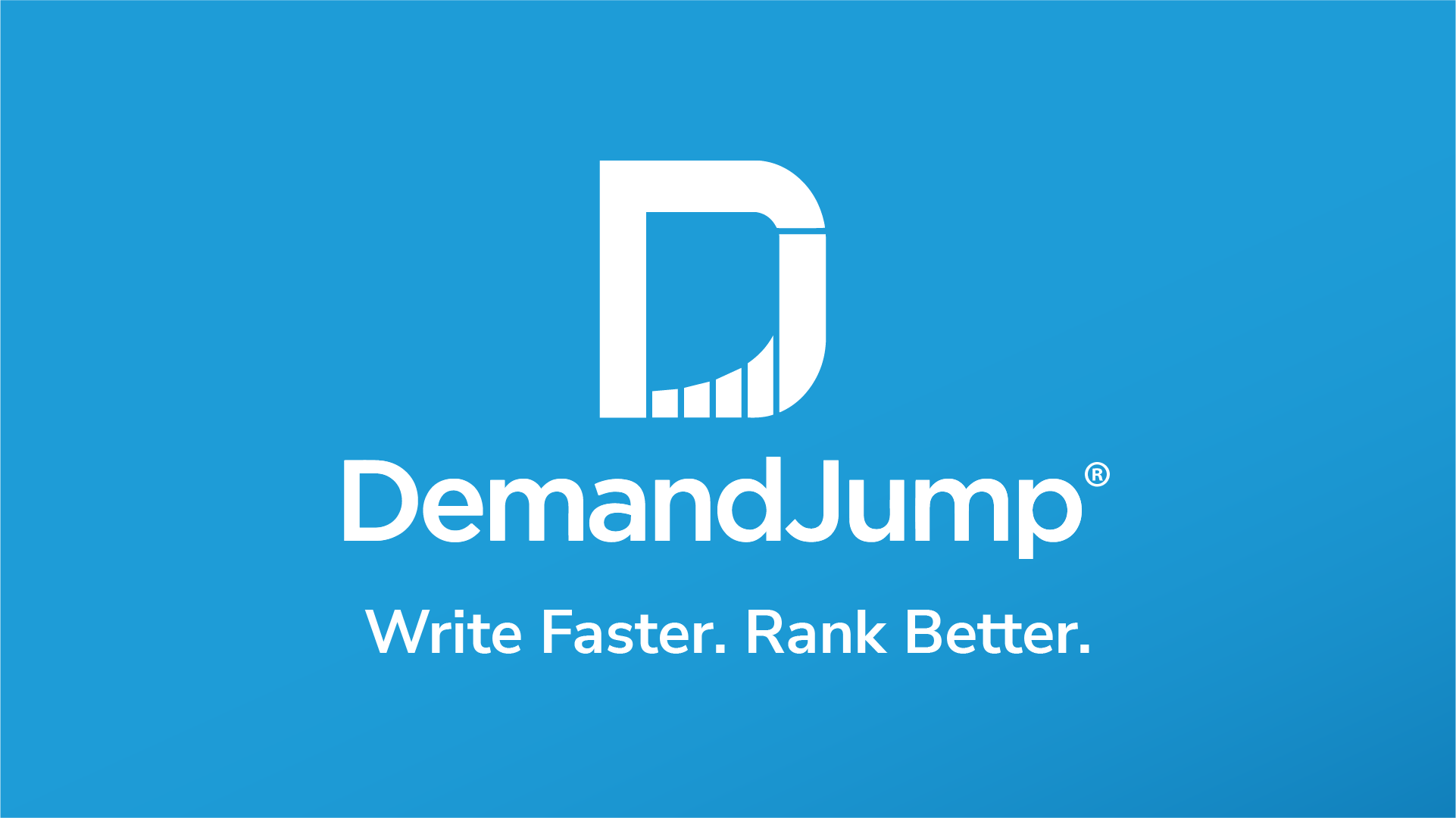B2B Software-as-a-Service (SaaS) content marketers really have their work cut out for them. That’s because marketing a SaaS platform simply isn’t the same as trying to sell a concrete product. So, how do you effectively capture the benefits of one SaaS platform over another, especially when their differences are highly nuanced? Making things even more complicated, many SaaS transactions are based on a subscription model, as opposed to being one-and-done transactions. This means SaaS marketers have to find clever ways to present compelling value over time, to attract and engage customers, and provide them with enough value that re-upping’s a no-brainer.
What we’re saying shouldn’t come as a total shock. The importance of designing and deploying an effective SaaS content marketing strategy seems to be well understood by companies. According to the Content Marketing Institute (CMI), a majority of B2B and B2C companies (91% and 86%, respectively) understand “that content marketing is a fundamental strategy for SaaS.” What’s more, 73% of these companies say they do have a content marketing strategy—these, of course, are not all created equally. Without going into too much depth here, this essentially means two things for would-be SaaS content marketers:
- You’ll need an understanding of content marketing if your SaaS business is going to compete, succeed, and grow.
- “Good enough” might not be good enough—but keeping up with modern best practices can help to drive positive results.
Whether you’re dabbling as a freelance SaaS writer or you’ve already assembled a whole Saas writer portfolio and are looking for a few new tips, you’ve come to the right place! We’ve put this resource together—our Ultimate Guide to Saas Content—to help you hit the ground running with some best practices for how to write SaaS content that drives results. In it, we’ll answer three big questions: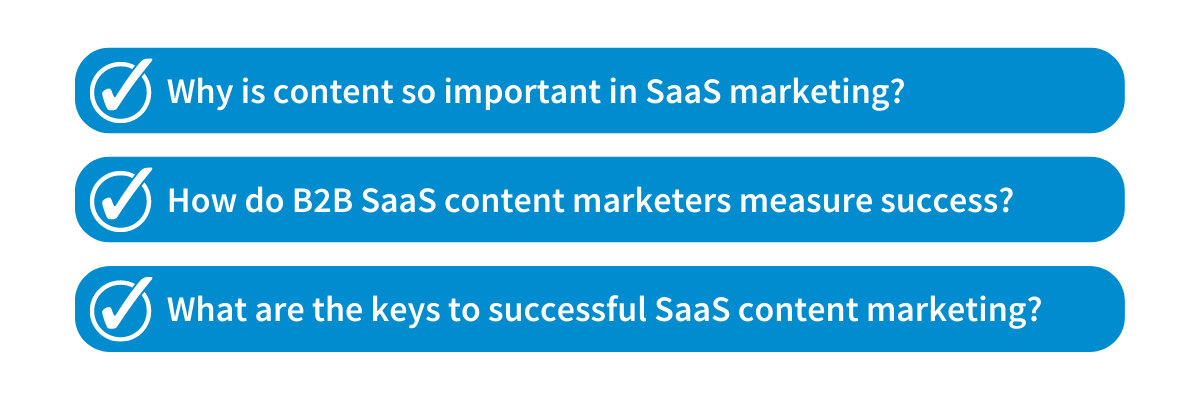
Why Is Content So Important in SaaS Marketing?
Effective content writing can be a truly powerful tool for a business of any size and in virtually any industry, especially when that tool is wielded by a pro.
That being said, content creation for SaaS companies is just one piece of an all-important equation. Here, it’s important to distinguish between the terms content, content strategy, and content marketing. They’re each different, but they’re closely related to each other:
- Content can describe any material—written or otherwise—that a company develops in order to educate and connect with its target customers. For a SaaS company, content can serve countless purposes, from capturing followers’ attention on social media to engaging and converting prospective customers.
- A content strategy is a framework for producing and delivering content. Why is a content strategy so important? Rather than publishing content randomly and hoping for the best, a well-developed strategy will help you to be more efficient and effective in your content production, likely increasing its ROI. Your content marketing strategy primarily serves to ensure you hit the right people with the right message(s) at the right time(s).
- Finally, content marketing describes a comprehensive approach to content strategizing, writing, publishing, and promotion. What content marketing for your business will look like is going to depend on your strategy’s objectives—connecting with a new audience segment or growing a specific product or service line, for example.
What Role Do Search Engines Play in SaaS Marketing?
Modern search engines use complex algorithms in an attempt to understand user search queries and the types of website content those searchers are likely to find useful and relevant. Look no further than Google’s recent helpful content update, designed to “ensure people see more original, helpful content written by people, for people, in search results.”
How does this update work? It’s a little complicated…but in short, it uses machine learning to automatically evaluate published content in order to classify it as helpful or unhelpful. The most important takeaway from this update is the importance of writing human content for human readers. It’s all about creating the kind of content that can connect with prospects and help them understand how your product/service offerings can address their most compelling pain points.
Your future customers are out there—and will likely turn to a search engine when they’re looking for information, so the B2B SaaS content writer should focus on creating content that attracts and engages their ideal customers. In other words, getting them to your website is one thing—answering their questions and providing relevant information is another altogether. Content marketing helps you be there, for them, with the exact answers (and solutions) they’re looking for.
When you understand what Google is looking for, the value of Pillar-Based Marketing (PBM), our specialty, becomes apparent.
You’re probably wondering, “what is Pillar-Based Marketing?” In short, it’s an example of a specific content marketing approach that empowers companies to produce consistent, high-quality content that search engines—and customers—will both find value in. By producing a network of topically-related content, a company positions itself as a trustworthy authority on a given topic.
A typical PBM plan consists of 16 pieces of interlinked content, including one piece of Pillar content, three Sub-Pillars, and a dozen Supporting Blogs:
- A 3,000-word Pillar offers a comprehensive overview of a broad topic. (You’re reading one right now!) These pieces of content will typically have titles like “The Ultimate Guide to [X]”, which signals to readers that they’re about to read something that goes into a decent amount of depth.
- 3 Sub-Pillars of around 2,000 words each. These are like mini-Pillars, each exploring a specific aspect of the Pillar topic and linking to the original Pillar page. (Within this Pillar plan, we’ll be publishing Sub-Pillars focused around SaaS marketing companies, content ideas for SaaS companies, and information about SaaS marketing course options.)
- 12 Supporting Blogs, each geared toward answering a specific question related to the Pillar/Sub-Pillar topics. These are meant to answer the exact questions prospective customers are asking. Ultimately, 3 Blogs will link to each Sub-Pillar (and the Pillar), and 3 will only link to the Pillar itself.
Here’s how all of your high-quality SaaS content can be linked together:
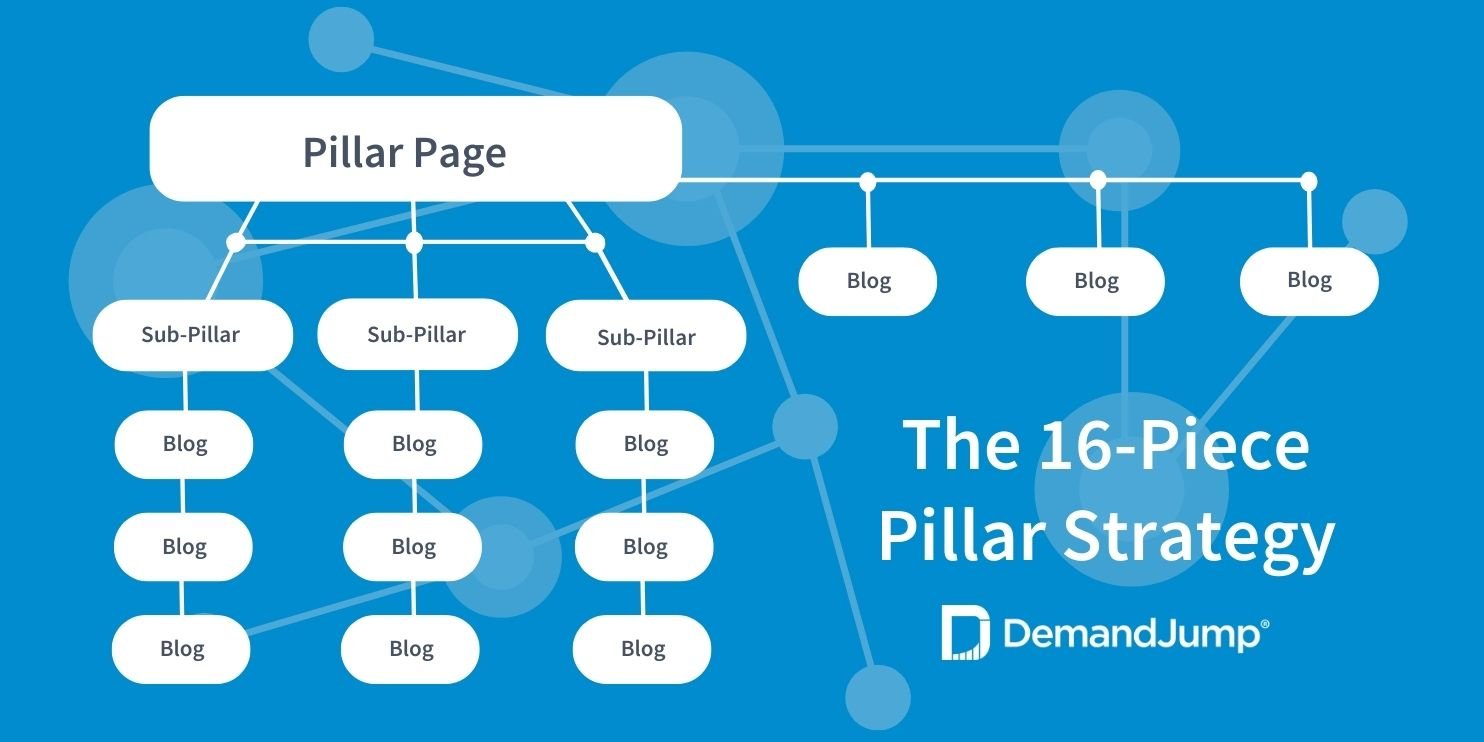
This linking structure signals to Google (and other search engines, presumably) that your content, website, and company are credible and appropriately geared toward human readers.
How Does Content—and Content Marketing—Benefit SaaS Companies?
A number of compelling benefits come with successful content marketing, mainly centered around the development of productive, long-term relationships with high-value customers.
From a marketers’ perspective, the distinct advantages of B2B SaaS content marketing include its ability to help companies:
- Develop a consistent and effective brand voice and increase brand awareness.
- Establish credibility, positioning a company as being a trustworthy authority—thought leader, even—within their industry.
- Drive traffic to your website, from internet searchers who might be looking for the exact type(s) or products/services you offer.
- Effectively move prospective customers through the awareness, consideration, and decision stages of the buyer’s journey.
- Complement a number of common other marketing strategies like search engine optimization, social media and email marketing, paid ads, and more.
- Experiment and gauge results over time, to develop a deeper understanding of your ideal customers and the types of content they find most useful and influential.
Speaking of useful, what do customers expect from a B2B SaaS company’s content? Whether they realize it or not, they’re looking to work with companies that understand them, are willing to learn about their pain points and priorities, and provide consistent engagement and messaging throughout—and even beyond—the buying process.
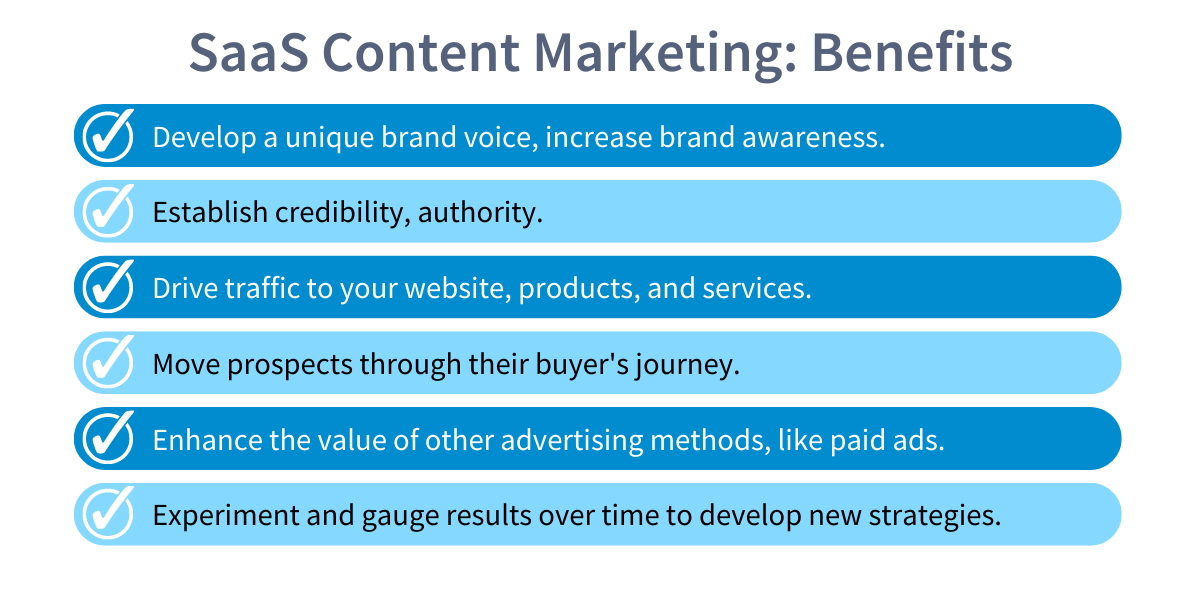
How Do B2B SaaS Content Marketers Measure Success?
Another way to think about the benefits of content marketing for SaaS companies is to explore some of the best measures of content marketing success. There are five categories of metrics you can use to measure the effectiveness of your B2B SaaS content writing campaign, shown below: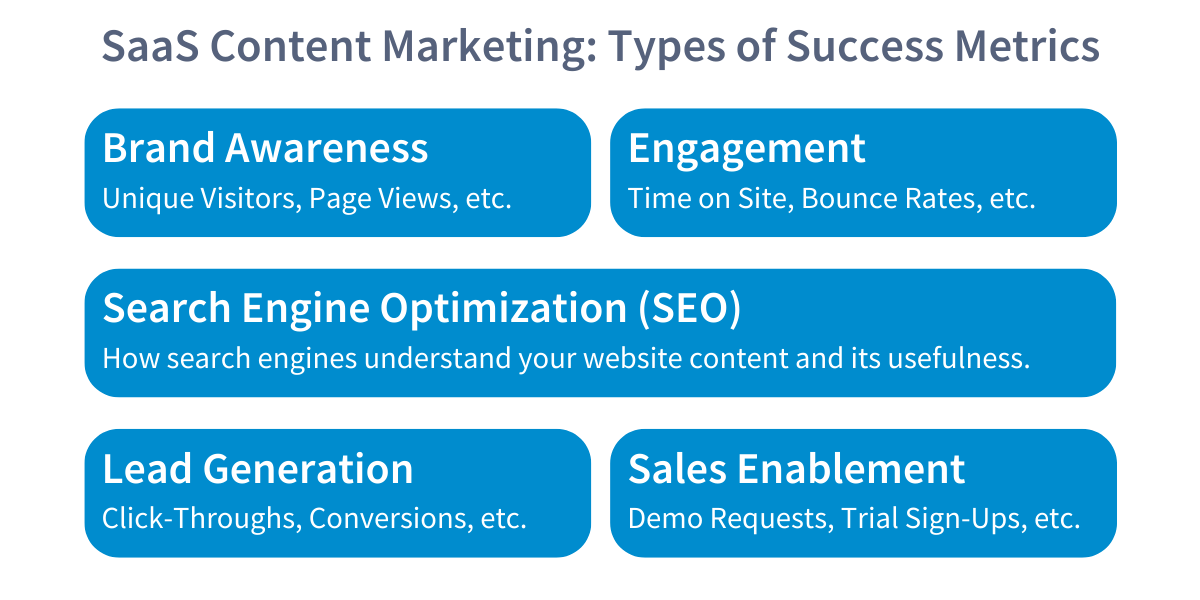
Brand Awareness
These metrics gauge how familiar your customers are with your company, product, and/or service. If they don’t know you exist, they certainly can’t do business with you! A few solid brand awareness metrics include website statistics like unique users (website visitors), pageviews (per page), and unique pageviews (by a single visitor). Create and publish engaging and informative content to connect with prospects and educate them about what you’re offering.
Engagement
These metrics help companies who are already getting a decent amount of website traffic to better-understand where these customers are coming from, how they’re finding your content, and how likely they might be to do business with you. Engagement metrics are primarily used to quantify how visitors behave once they find your website. These can include their total time on your site, time spent reading website content, click-through and bounce rates, and social media shares.
Search Engine Optimization (SEO)
These metrics provide insight into how your content is performing when potential customers are searching for information related to your product or service offerings. Content marketers can use Google Search Console to review their performance and identify opportunities to improve their search engine results page (SERP) rankings.
As we’ve already discussed, the algorithms behind how major search engines (like Google) display results are designed to reward companies that produce genuinely helpful—not spammy—content. Page authority (how your pages rank) and domain authority (how relevant and credible your site is) are two key measures to consider. These can be difficult for rookies to measure and understand, but DemandJump’s SEO keyword research and content strategy planning tools can do much of the heavy lifting.
Lead Generation
These metrics can illuminate how customers engage with your content in a way that progresses them through an optimal buyer’s journey. Two of the most important lead generation metrics for B2B SaaS content marketers are click-through rates and conversions. Click-through and conversion rates can be used to measure how frequently the readers of your content take one or more intended actions—like clicking on a Call-to-Action (CTA) button or following a link to schedule a product demo, for example.
Sales Enablement
These metrics are ideal for companies that want to use content to grow sales, and commonly include things like demo request sign-ups, sales conversion rates, and sales cycle length. Generally speaking, content marketing is meant to move prospects through an ideal buying journey that consists of three main stages: awareness, consideration, and conversion. When content is engaging—and produced/published according to a well-designed content strategy—it streamlines the buying journey and increases the strategy’s potential ROI by simplifying content creation and publication processes.
What Are the 3 Keys to a Successful SaaS Content Strategy?
Like virtually anything else, successful content creation and marketing for SaaS companies comes down to having—and executing—an excellent plan. This is where things can get interesting, since there are so many variables to consider when developing your own objectives strategy. There are three main keys to success:
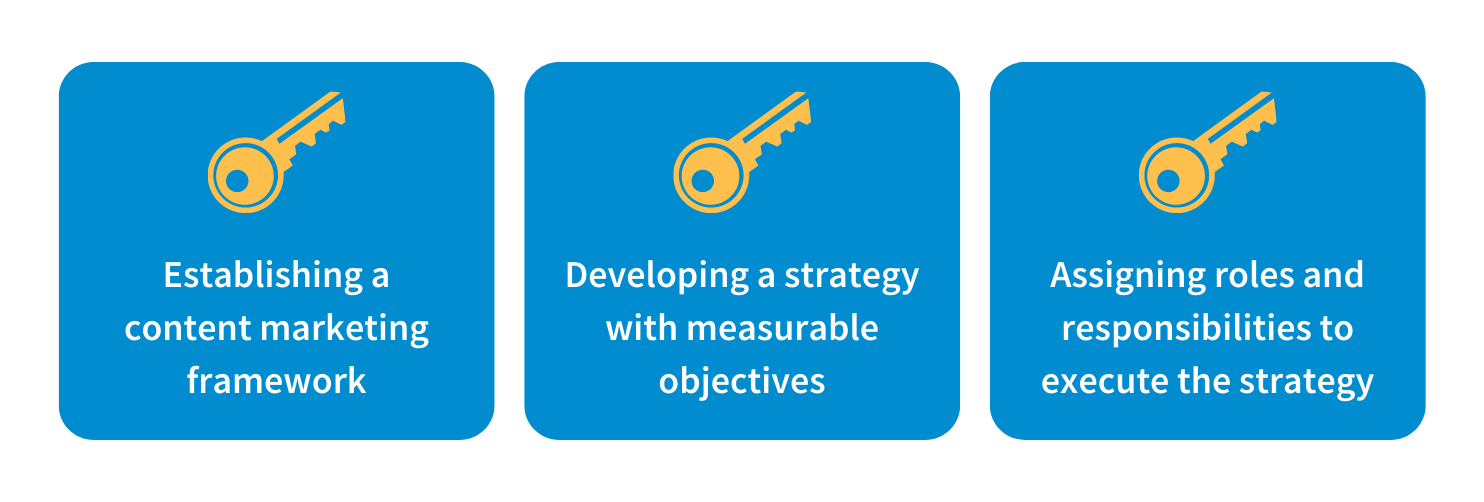
Let’s take a closer look at each of these three keys to success, so you can have everything you need to get started on your own framework and strategy.
What Is a Content Marketing Strategy Framework, and How Do You Develop One?
A content marketing strategy framework essentially serves as the scaffolding or foundation on which you’ll execute your content strategy. It provides a structure that helps to ensure that your content strategy is well-planned, and that its ideal outcomes are both realistic and impactful.
The first step to designing a successful content marketing framework involves asking a series of questions. First, to identify the strategy’s objectives and then to think through how it will achieve them. To ensure that your strategy aligns with what your customers are actually looking for, start by asking these questions:
- “Who is this for?” Developing an ideal customer profile will help you determine the best target audience for your content strategy. The question of who you’re targeting will influence not only what type of content to write, but the appropriate tone or voice to use as well.
- “What solutions/value can we provide?” Based on what you understand of your ideal customer profile, you can start to prioritize their pain points. Then, you can determine what types of content to create that will demonstrate that you understand the customer and have a compelling product/service offering for them to consider.
- “Why should they choose/trust us?” Especially in a B2B setting, customers want to do business with companies they feel like they can relate to and trust. By writing content that addresses their pain points, in a language they can easily understand, a company can position themselves as a credible authority within the industry.
- “What sets us apart from our competitors?” As much as you may not want to admit it, most B2B SaaS companies are not entirely unique. Part of this is just due to the fast-moving nature of the software industry. For better or worse, as soon as one product or platform gains traction, it doesn’t take long for imitators to jump into the game. A company can differentiate itself from its competitors by establishing a relatable and distinct brand voice and consistently publishing great content.
Once these questions have been answered, you can start thinking through more concrete, strategy-oriented questions, like:
- “How are we going to do this?” This includes overall strategy development, as well as creating a content calendar or roadmap to identify the individuals and teams that might be necessary for subject matter expertise, collaboration, and so on.
- “Who does what?” Depending on how the team is organized, you may already have procedures in place for delegating tasks, or you might be developing these processes on the fly. Either way, successful execution requires everyone to understand exactly what’s expected of them—and when. We’ll cover the different roles within a content team a little later.
- “When will the strategy be completed?” Setting specific timelines will help to ensure that content is created in a timely and efficient manner, so it can reach the right audience when they’re exploring their options (before they potentially settle for a competitor).
Now that we’ve literally covered the who, what, when, where, why, and how of developing a content marketing framework, let’s keep moving. Next, we’ll discuss the elements of an effective content marketing strategy—and outline the roles, responsibilities, and contributions required for a successful campaign.
What Are the Must-Have Elements of a SaaS Content Marketing Strategy?
Considering the primary objective of content marketing—to attract, engage, and convert prospects into loyal, paying customers—the most essential elements for developing an effective strategy include:
- Audience Research: The better you understand your ideal customer profile(s), the better your chances for producing the type(s) of content that will resonate with them.
- Competitor Analysis: By considering your best opportunities for competitive differentiation, you can focus your efforts toward producing high-value, conversion-likely content.
- A Clear Mission or Objective: Who are you trying to reach, and what do you want from them? Once you know these answers, you can outline the best approach from a content standpoint.
- Metrics to Measure Success: Without clear, measurable objectives, it can be difficult to gauge how well a strategy is performing. Depending on your industry and company type, you might target metrics designed to measure brand awareness, engagement, SEO, lead generation, or conversions.
- Keyword Research and Content Planning Tools: Modern platforms like DemandJump provide marketers with intuitive and actionable SEO keyword research and content planning tools designed to uncover compelling content ideas for SaaS companies. Using these helps ensure that your content writers will understand customers’ pain points and priorities, so they can write excellent content right from the start.
What Are the 4 Steps of Content Strategy Development?
There are 4 main steps to develop an effective B2B SaaS content marketing strategy:
- Step 1: Set Your Objectives. You can’t go wrong with SMART objectives—which are specific, measurable, achievable, relevant, and timely. Creating SMART objectives helps to ensure that the content you create and deliver is well-aligned with your target audience and their buying preferences.
- Step 2: Develop a Content Roadmap. A detailed content roadmap or content calendar simplifies the process of assigning specific content pieces to specific writers. As discussed earlier, search engines like Google prioritize what they determine to be useful, human content. Part of what their algorithms consider is not just what you write and publish, but how those pieces work together to form a “content ecosystem” that demonstrates a thorough understanding of a given topic. Pillar-Based Marketing capitalizes on the importance of helpful content, and makes developing a rock-solid strategy surprisingly intuitive.
- Step 3: Write! Once you’ve identified your content objectives and the topics you’ll address, you can delegate assignments and get your content creation machine firing on all cylinders. To many content marketers, the revision and editing processes are just as important as the writing itself. By having writers either workshop each other’s writing or designating a trusted “editor”, companies can ensure a consistent brand identity and aligned messaging that establishes credibility.
- Step 4: Publish (and Promote). Coming up with creative ways to promote your content via social media channels is a great way to supercharge your content strategy. Social media promotion helps to increase brand awareness and extend the reach of your content beyond just organic search traffic. Coming up with social media content ideas for SaaS companies shouldn’t feel like rocket science. If your company already has an established social media presence, then you can easily promote content on any of those platforms—just tailor your social media posts to align with your brand voice on each platform.
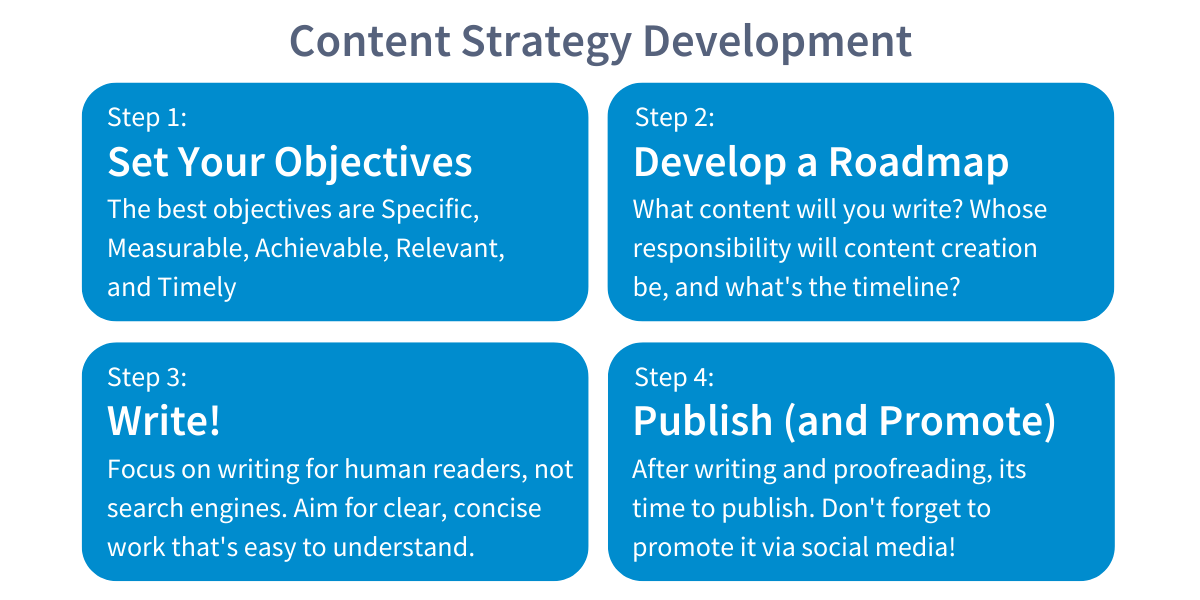
What Are Content Marketing Team Members’ Roles and Responsibilities?
Content marketing can be done in-house, outsourced to freelance writers (or a B2B SaaS content marketing agency), or these approaches can be combined. Either way, here are the main roles/responsibilities to account for, from big-picture strategy development to the nitty-gritty of content creation:
- Chief Content Officer (or Director of Content Marketing): The person in the role is ultimately in charge of content marketing, and their responsibilities include:
- Identifying and prioritizing content marketing objectives and key performance indicators (KPIs) for gauging effectiveness.
- Assigning roles and responsibilities within the content (or content marketing) team, and identifying opportunities for collaboration and alignment with other teams (sales, for example).
- Developing effective and repeatable processes for content creation, publication, and promotion.
- Empowering their team members with the tools and strategies they need to be successful.
- Content Marketing Manager: This individual focuses on translating the Chief Content Officer or Director of Content Marketing’s objectives and strategy into an actionable roadmap for content development and publication. This manager’s roadmap sets specific roles and responsibilities among team members, including role- and objective-specific timelines and KPIs.
- Content Writers: Despite their modest title, dedicated Content Writers are no less important than the manager(s) and/or director(s) above them in the organizational chart. They create the actual content that makes the whole strategy work. Once a content strategy has been roadmapped, pieces can be assigned to specific content creators who will bridge the gap between the art (of writing engaging, human content) and the science (of keyword research and analytics).
- Editors and Editorial Assistants: In larger, enterprise-level companies, there are typically enough resources available for some contributors to specialize in editing and publishing content. Editors may serve in copy-editing or proofreading roles, while editorial assistants might be more like project managers, responsible for uploading content, including the right hyperlinks and images, and so on. While having one or more dedicated editors and editorial assistants can help ensure that consistent standards are applied across all related content, that’s not a luxury that will fit every company’s budget. To that end, smaller companies can often get by with having writers edit their own—or each other’s—pieces before they’re published.
It’s worth noting that not every company is going to need to fill each of these roles individually. Sure, for an enterprise-level company, these responsibilities can be assigned to different individuals or teams, but what about smaller companies? In many cases, smaller organizations will benefit from a more streamlined organizational structure, where roles and responsibilities are combined.
Better SaaS Content Starts with DemandJump
DemandJump’s platform was designed with modern content marketers in mind, and provides the tools and insights needed for developing an effective content marketing framework and strategy. It makes it easy to identify and implement best practices for growing your business and driving a high ROI on content marketing initiatives.
Ready to elevate your content game, and harness the power of DemandJump and Pillar-Based Marketing? Use our SEO keyword research and content planning tools to gain a full understanding of your target audience(s), including their pain points and priorities. Our tools show you exactly what your customers are searching for, and identify your best opportunities to create the kind of content that will speak to their concerns and help them make the right decisions for their business. You can even see how you rank for any given keyword or keyword phrase against your top competitors, to prioritize the most compelling content objectives. With all of that intel in tow, then, you’ll be well on your way to developing highly-effective content in line with recommended content marketing methods and best practices.
Inspired to write? Ready to learn more? DemandJump empowers companies to develop winning strategies with minimal headaches. Click the button below to jump right into the platform, to give it a try (for free). You can also read some customer stories or listen to an episode of our Page One or Bust! podcast for useful content marketing examples and success stories.







